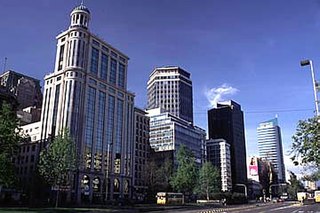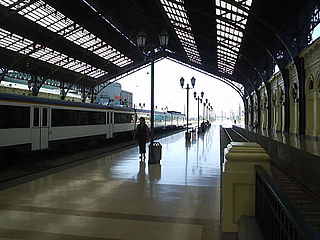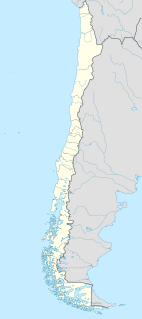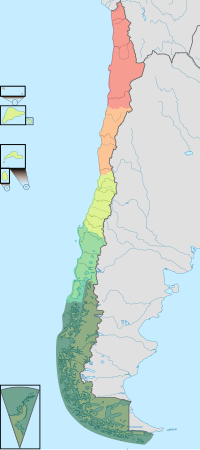
Transport in Chile is mostly by road. The south of the country is not connected to central Chile by road, and water transport also plays a part there. The railways were historically important in Chile, but now play a relatively small part in the country's transport system. Because of the country's geography and long distances between major cities, aviation is also important.

Concepción is a city in central Chile and the core of the commune and metropolitan area of Greater Concepción, the country's second largest urban conurbation. It has a significant impact on domestic trade being part of the most heavily industrialized region in the country. Its location is in the called Zona Centro Sur, in the geographic center of the country, and it is the capital of the Concepción Province and Bío Bío Region. It sits about 500 km south of Santiago, the country's capital.

Temuco is a city and commune, capital of the Cautín Province and of the Araucanía Region in southern Chile. The city is located 670 kilometres south of Santiago.

The Biobío Region, is one of Chile's sixteen first-order administrative divisions. With a population of 1.5 million people, it is divided into three provinces: Arauco, Biobío and Concepción. In the Bio Bio, Concepción is the capital and largest city. Other important cities include Coronel, Hualpén, Los Ángeles, and Talcahuano.

The Araucanía, Araucanía Region is one of Chile's 16 first-order administrative divisions, and comprises two provinces: Malleco in the north and Cautín in the south. Its capital and largest city is Temuco; other important cities include Angol and Villarrica.

Santiago Province is one of the six provinces of the Santiago Metropolitan Region (RM) of central Chile. It encompasses the majority of the population of that region, including 31 of the 36 communities of Greater Santiago. The province spans 2,030.30 km (1,262 mi).

The Biobío River is the second largest river in Chile. It originates from Icalma and Galletué lakes in the Andes and flows 380 km to the Gulf of Arauco on the Pacific Ocean.

Empresa de los Ferrocarriles del Estado (EFE) is the national railway of Chile.
The Central Valley, Intermediate Depression, or Longitudinal Valley is the depression between the Chilean Coastal Range and the Andes Mountains. The Chilean Central Valley extends from the border with Peru to Puerto Montt in southern Chile, with a notable interruption at Norte Chico. South of Puerto Montt the valley has a continuation as a series of marine basins up to the isthmus of Ofqui. Some of Chile's most populous cities lie within the valley including Santiago, Temuco, Rancagua, Talca and Chillán.

Central Chile is one of the three natural regions into which CORFO divided continental Chile in 1950. It is home to a majority of the Chilean population and includes the three largest metropolitan areas—Santiago, Valparaíso, and Concepción. It extends from 32° south latitude to 37° south latitude.

The Zona Sur is one of the five natural regions on which CORFO divided continental Chile in 1950. Its northern border is formed by the Bío-Bío River, the limit with the Central Chile Zone. By west with the Pacific Ocean, by the east with the Andean mountains and Argentina. Its southern border is the Chacao Channel, beyond it lies the Austral Zone. While Chiloé Archipelago belongs geographically to Zona Austral in terms of culture and history it lies closer to Zona Sur.

Because Chile extends from a point about 625 kilometers north of the Tropic of Capricorn to a point hardly more than 1,400 kilometers north of the Antarctic Circle, within its territory can be found a broad selection of the Earth's climates.
German Chileans are Chilean citizens who derive their German ancestry from one or both parents. They are chiefly descendants of about 30,000 immigrants who arrived between 1846–1914, most following the Revolutions of 1848 in the German states.

Agriculture in Chile encompasses a wide range of different activities due to its particular geography, climate, geology and human factors. Historically agriculture is one of the bases of Chile's economy, now agriculture and allied sectors—like forestry, logging and fishing—account only for 4.9% of the GDP as of 2007 and employed 13.6% of the country's labor force. Some major agricultural products of Chile include grapes, apples, onions, wheat, corn, oats, peaches, garlic, asparagus, beans, beef, poultry, wool, fish and timber. Due to its geographical isolation and strict customs policies, Chile is free from diseases such as Mad Cow, fruit fly and Phylloxera, this plus being located in the southern hemisphere and its wide range of agriculture conditions are considered Chile's main comparative advantages. However, the mountainous landscape of Chile limits the extent and intensity of agriculture so that arable land corresponds only to 2.62% of the total territory.

Since the mid-1990s, tourism in Chile has become one of the main sources of income for the country, especially in its most extreme areas. In 2005, this sector grew by 13.6%, generating more than US$500 million, equivalent to 1.33% of the national GDP.

The following is an alphabetical list of articles related to the Republic of Chile.

The Mapuche Conflict is a collective name for the revival and reorganization of Mapuche communities for greater autonomy, recognition of rights, and the recovery of land since the Chilean transition to democracy. The Mapuche conflict is a phenomenon mainly from Chile, but also from neighboring areas of Argentina. Demands revolve mainly around three themes: jurisdictional autonomy, return of ancestral lands, and cultural identity. The Mapuche conflict has generated debates that take place in different areas, from the legal discussion through the historiographic controversy about their status as indigenous peoples to the controversial use of the term of terrorist. Historian Gonzalo Vial claims that a "historical debt" exists towards the Mapuche by the Republic of Chile, whereas the Coordinadora Arauco-Malleco aims at a national liberation of Mapuches.
Radio Bío-Bío is a (mostly) news Chilean radio with broad coverage in Chile.

The 2010 Pichilemu earthquake, also known as the Libertador O'Higgins earthquake, was a 6.9 MW intraplate earthquake that struck Chile's O'Higgins Region on 11 March 2010. The earthquake was centred 15 kilometres (9.3 mi) northwest of the city of Pichilemu.

In Chile, coal mining is restricted to a few places located in its southern half. Energy originating from coal stands for 11,6% of Chile's electricity consumption. Currently the country is not considered a major producer of coal.

















